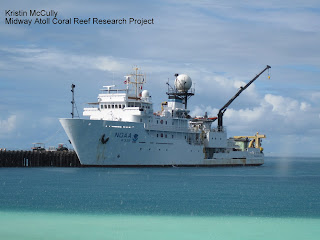Since Don arrived on Thursday, I’ve kept him very busy doing lots of forereef dives for my bivalve surveys (8 so far in 3 days). Forereef dives are always exciting because they’re deeper, with potentially stronger currents and waves, and unprotected by the atoll rim. Plus, they look very different and have different fishes, corals, and other organisms. There are also a lot more bivalves than we see inside the reef!
While diving, we’ve observed lots of bivalves, nudibranches, crown-of-thorns sea stars (which, in large numbers, cause problems in other places, but haven’t caused a problem yet in the Northwestern Hawaiian Islands), sharks, giant trevallies (uluas), Potter’s angelfishes, Hawaiian morwongs, and much more. Here's Don collecting a sediment sample behind an endemic (and relatively rare) Hawaiian morwong.
While outside the reef on the boat, we watched 2 big manta rays just outside the channel and several brown boobies sitting on the reef or on buoys. The manta rays were particularly cool because we don’t see them very often and these stayed on the surface close to us long enough to get good photos!
I let Don take a land day on Sunday while I took the new FWS volunteers Dani, Eamon, and Anthony out to collect coral reproductive samples. It’s a good project to take others out for, because they get to see at least three totally different habitats and they can just snorkel around for fun while I work. They were very excited when a monk seal followed us around for a while and we saw a shark.
I was very excited that they helped me find the first live adult pearl oyster I’ve seen for most of the summer!!
While Don and I have been diving, Anne’s been finishing measuring the piers and analyzing that data, preparing and testing our underwater video camera, and much more.
I posted a lot more photos today at http://picasaweb.google.com/MidwayCoralReef/2011.
I posted a lot more photos today at http://picasaweb.google.com/MidwayCoralReef/2011.


















